Table of Contents
The British Coastline offers access to waters that are rich with a variety of fish species, ranging from permanent residents to those who migrate at different points in the year. Unfortunately, the impact of commercial fishing has meant the decline of some species while simultaneously increasing others. Even sharks and Killer Whales have been reported in some areas of the UK!
Crabs
Broad-Clawed Porcelain Crab
The broad-clawed porcelain crab is a small crab, measuring 2 cm in length. It has a hairy body and large, flattened front claws, with a grey or brown colouration.
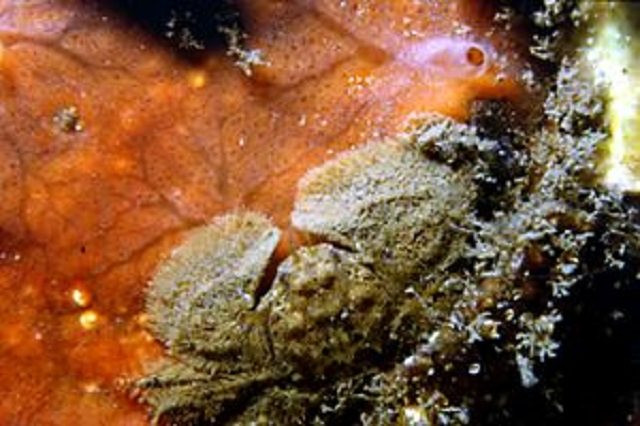
Massimiliano DE MARTINO, CC BY-SA 3.0, via Wikimedia Commons
| Latin Name | Porcellana platycheles |
| Diet | Filters plankton from the water, but will also feed on dead animals and plant matter. |
| Best time to see | July to October. |
| Distribution | Broad-clawed porcelain crabs are widely distributed around the UK. |
| Habitat | Rocky areas with gravel bottoms are preferred, usually in the intertidal region. |
| How to find | Snorkelling/Diving. |
| Interesting fact | Named for their fragility, broad-clawed porcelain crabs can shed their legs if grabbed by predators, a strategy which helps them to escape being eaten. |
Common Hermit Crab
Common hermit crabs have reddish-brown bodies with white markings. They live inside the abandoned shells of sea snails such as whelks and periwinkles. They measure 3.5 cm in length.

Photo: © Hans Hillewaert
| Latin Name | Pagurus bernhardus |
| Diet | An opportunistic scavenger, this species will eat almost anything, including dead creatures, seaweed and plankton. |
| Best time to see | July to October. |
| Distribution | Common hermit crabs are found right around the UK coast, but are slightly less common in northern Scotland. |
| Habitat | Lives on both rocky and sandy shores, down to a depth of 140 m. |
| How to find | Rockpooling/Snorkelling/Diving. |
| Interesting fact | Common hermit crabs often fight amongst each other for the best shells, with the victor forcibly evicting the loser and taking the desired shell as their own. |
Circular Crab
The circular crab is a small crab, usually measuring about 4.5 cm in length. It has a rounded shell, hence its name, with a reddish-brown colour and a body that is fringed in hairs.
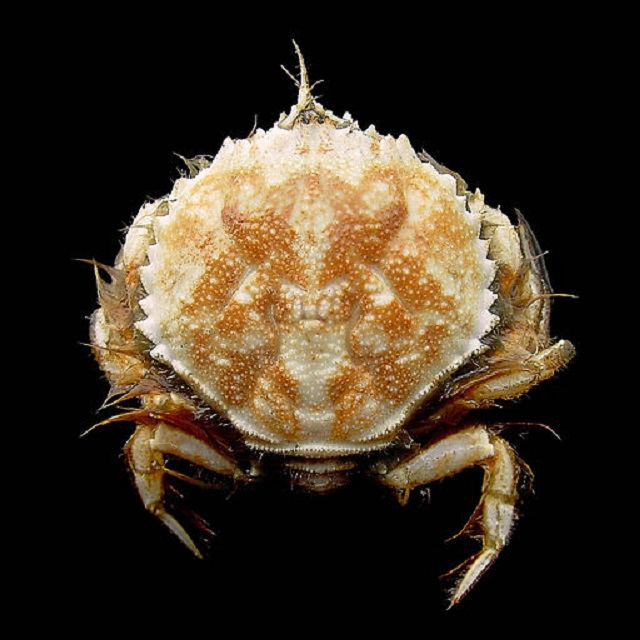
Photo: © Hans Hillewaert
| Latin Name | Atelecyclus rotundatus |
| Diet | Mainly dead marine creatures and plant matter. |
| Best time to see | July to October. |
| Distribution | Circular crabs are found on much of the UK coast, with the greatest numbers in the south of England. |
| Habitat | Can be seen on rocky or sandy shores, down to a depth of 300 m. |
| How to find | Rockpooling/Snorkelling/Diving. |
| Interesting fact | The circular crab buries itself by digging backwards into the sand, and reverses its respiratory water flow to pump water out of its legs, instead of drawing it in. This prevents suffocation. |
Edible Crab
Edible crabs have distinctive orange-brown carapaces, with black tips to their claws. They are large crabs, measuring 15 cm in length on average.

Photo: © Hans Hillewaert
| Latin Name | Cancer pagurus |
| Diet | Small crabs are their preferred food, although molluscs and lobsters may also be eaten. |
| Best time to see | May to August. |
| Distribution | Edible crabs are abundant right around the UK coastline. |
| Habitat | Mainly found in cracks and holes within rocks, to a depth of 100 m. |
| How to find | Rockpooling/Snorkelling/Diving. |
| Interesting fact | As many as 10,000 tons of edible crabs are caught in the English Channel each year, making the species the most important commercial crab in Europe. |
Great Spider Crab
Great spider crabs have pear-shaped carapaces, which are usually brown in colour. Their limbs are long, slender and spider-like, and their bodies measure around 8 cm in length.
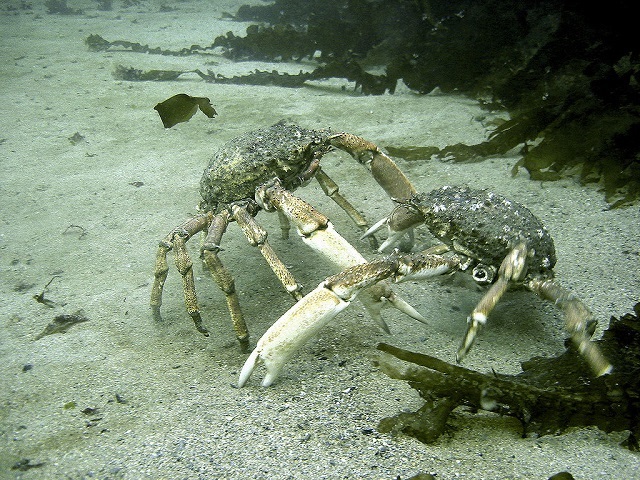
Joebater at the English Wikipedia, CC BY-SA 3.0, via Wikimedia Commons
| Latin Name | Hyas araneus |
| Diet | Largely made up of dead marine life, although plankton and small fish may be caught. |
| Best time to see | July to October. |
| Distribution | Great spider crabs are most common in the south-east of England, although they can be seen right around the UK. |
| Habitat | Usually found around rocky areas and seaweed, to depths of 50 m. |
| How to find | Snorkelling/Diving. |
| Interesting fact | The carapaces of great spider crabs are often covered in algae and other marine life, providing them with excellent camouflage. |
Long-legged Spider Crab
The long-legged spider crab has a grey or reddish-brown carapace, with very long, spindly legs. It is a small crab, with its body averaging 2 cm in length.
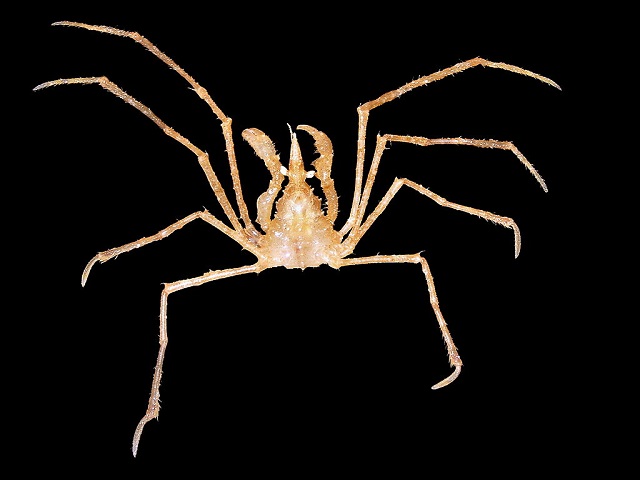
Photo: © Hans Hillewaert
| Latin Name | Macropodia Rostrata |
| Diet | Mainly scavenges dead animals, but will also filter feed for plankton. |
| Best time to see | July to October. |
| Distribution | Long-legged spider crabs are found right around the UK coast, especially in western regions. |
| Habitat | Often seen on muddy sand or in kelp forests, to depths of 100 m. |
| How to find | Snorkelling/Diving. |
| Interesting fact | Long-legged spider crabs are slow-moving and vulnerable to predators, so they disguise themselves by attaching pieces of algae to their legs. |
Northern Stone Crab
The northern stone crab is a large crab, with a body of around 12 cm in length. It is usually red or orange in colour, with spines all over its body and legs.
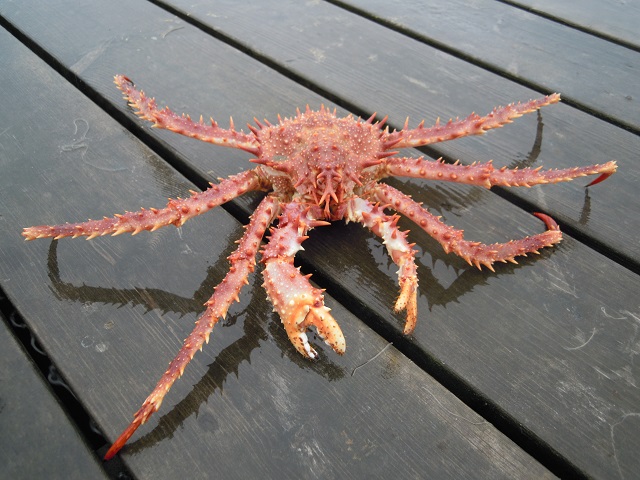
Photo by Arnstein Rønning, CC BY-SA 3.0, via Wikimedia Commons
| Latin Name | Lithodes maja |
| Diet | Mainly feeds on dead animals, as well as hunting for molluscs and sea urchins. |
| Best time to see | June to October. |
| Distribution | Northern stone crabs are largely distributed in the northern half of the UK, with a few sightings in England and Wales. |
| Habitat | Lives on both rocky and sandy coastlines, to depths of 1,000 m. |
| How to find | Snorkelling/Diving. |
| Interesting fact | The northern stone crab favours cold waters, and can be found as far north as Iceland and Greenland. |
Shore Crab
Shore crabs are variable in colour, although they are often green with a series of spikes on their shells. They have a broad carapace that measures around 6 cm long.
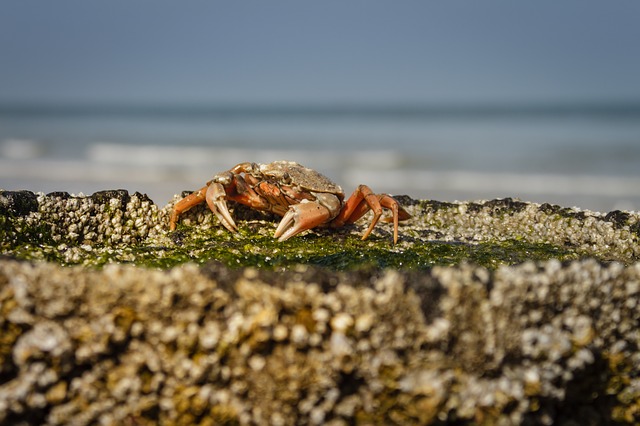 Photo: Christoph Schütz
Photo: Christoph Schütz
| Latin Name | Carcinus maenas |
| Diet | Preys on molluscs and other crabs. |
| Best time to see | June to October. |
| Distribution | The shore crab is a common sight on all UK coasts. |
| Habitat | Primarily a shallow water species, it can be found in rockpools, rocky coasts and sandy shores. |
| How to find | Rockpooling/Snorkelling/Diving. |
| Interesting fact | The colour of shore crabs is influenced by the environment. Green shore crabs are more tolerant of low oxygen levels, whereas red shore crabs are stronger and more aggressive. |
Velvet Swimming Crab
The velvet swimming crab is named after the distinctive short hairs that cover its body. It has red eyes, measures about 8 cm in length, and is generally brown with blue markings.
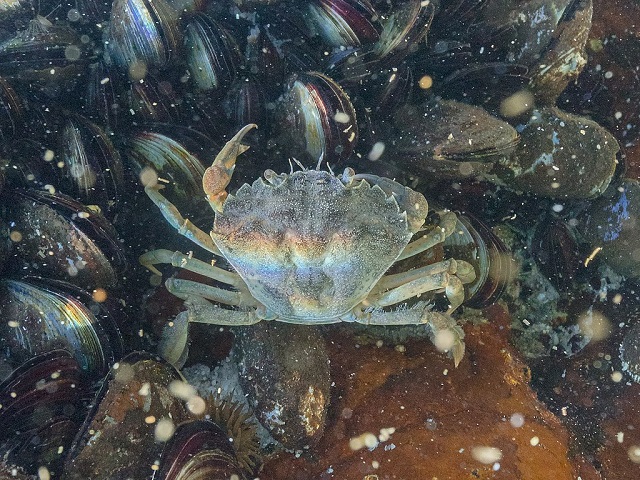
Photo: Diego Delso, CC BY-SA 4.0, via Wikimedia Commons
| Latin Name | Necora puber |
| Diet | Feeds on small fish and prawns, as well as molluscs. |
| Best time to see | June to October. |
| Distribution | Velvet swimming crabs are found on much of the UK coast. |
| Habitat | Sheltered shores are favoured, where the species can be found in rocky areas in shallow water. |
| How to find | Rockpooling/Snorkelling/Diving. |
| Interesting fact | As the name suggests, velvet swimming crabs are strong swimmers, using their flattened, paddle-like rear legs to propel themselves through the water. |
Lobsters
Common Lobster
The common lobster is very recognisable, with a distinctive blue carapace and two large, red antennae. It averages 30 cm in length, with two large front claws.
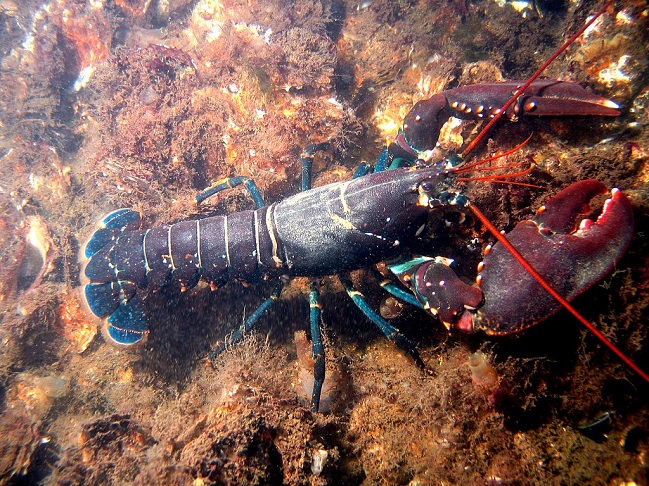
Photo: Bart Braun, Public domain, via Wikimedia Commons
| Latin Name | Homarus gammerus |
| Diet | Feeds predominantly on molluscs and crabs, although will scavenge almost anything. |
| Best time to see | July to October. |
| Distribution | The common lobster can be found on all UK coastlines. |
| Habitat | Primarily inhabits rocky areas in shallow waters, down to depths of 60 m. |
| How to find | Rockpooling/Snorkelling/Diving. |
| Interesting fact | The left claw of a common lobster is usually larger than the right and is used for crushing food, whereas the right claw is used for tearing. |
Olive Squat Lobster
Olive squat lobsters are small lobsters, usually measuring 5 cm in length. They are orange or brownish in colour, with two large front claws.
| Latin Name | Galathea squamifera |
| Diet | Filter feeds on plankton from the water, but will also scavenge for dead animals or catch small fish. |
| Best time to see | July to October. |
| Distribution | Olive squat lobsters are common around the UK coast, with the exception of north-east Scotland and north-east England. |
| Habitat | Lives under stones and in rock crevices, down to depths of about 180 m. |
| How to find | Snorkelling/Diving. |
| Interesting fact | Olive squat lobsters can use their tails as a powerful propulsion method. When disturbed, they clap their tails against their underbellies and shoot backwards at speed. |
Scampi
Scampi are narrow-bodied lobsters with pale orange colours. Their first three pairs of legs have claws, with the front pair being the largest. They average 21 cm in length.

Photo:© Hans Hillewaert
| Latin Name | Nephrops norvegicus |
| Diet | Preys on molluscs, worms and other crustaceans, as well as scavenging. |
| Best time to see | June to October. |
| Distribution | Scampi are common around northern coasts of the UK, but are generally not found around southern England or Wales. |
| Habitat | Prefers soft sediment in depths between 200 and 800 m, although is sometimes seen in shallower waters. |
| How to find | Snorkelling/Diving. |
| Interesting fact | Scampi like to create burrows in the soft sediment where they live, which they reside in for most of the day, before emerging at night to search for food. |
Spiny Lobster
Spiny lobsters are reddish-brown with yellow spots and spines all over their carapaces. They usually measure about 27 cm in length, and lack the large front claws of other lobsters.
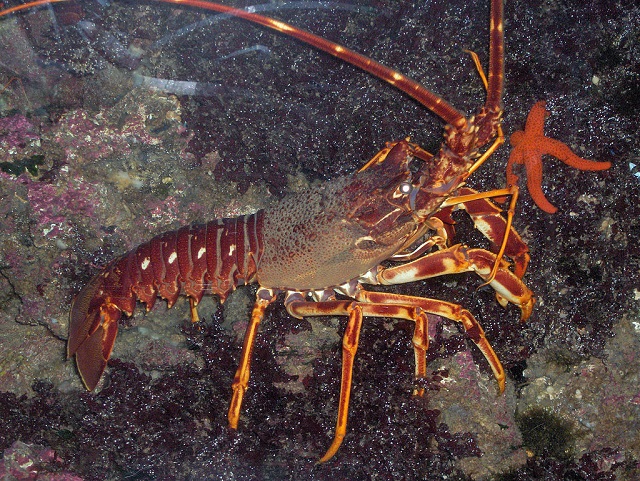
Photo; Georges Jansoone (JoJan), CC BY 3.0, via Wikimedia Commons
| Latin Name | Palinurus elephas |
| Diet | Will feed on dead animals, as well as hunting for worms and molluscs. |
| Best time to see | June to October. |
| Distribution | Spiny lobsters are mainly found on western coasts of the UK, but are patchily distributed. |
| Habitat | Rocky, exposed coastlines are favoured, to depths of around 400 m. |
| How to find | Snorkelling/Diving. |
| Interesting fact | Spiny lobsters are sometimes known as ‘creakers’, due to the creaking noise they make as they rub their antennae together to try and attract a mate. |
Spiny Squat Lobster
The spiny squat lobster is the largest squat lobster found in UK waters, measuring 9 cm in length. It is red in colour with vibrant blue stripes along the carapace and around the eyes.

Photo: Liné1, CC BY-SA 3.0, via Wikimedia Commons
| Latin Name | Galathea strigosa |
| Diet | Feeds largely on dead marine animals, but will also hunt for worms and molluscs. |
| Best time to see | June to October. |
| Distribution | Spiny squat lobsters can be found on many parts of the UK coast, being more common in the north-east. |
| Habitat | Lives on gravely and rocky bottoms, to depths of around 600 m. |
| How to find | Snorkelling/Diving. |
| Interesting fact | Spiny squat lobsters are difficult to get close to, as they are very shy creatures and can move rapidly when disturbed, using their tail as a paddle. |
Shrimp
Common Prawn
The common prawn is a large shrimp, measuring an average of 7 cm in length. It has a translucent body with brown stripes all along the body, and long antennae.
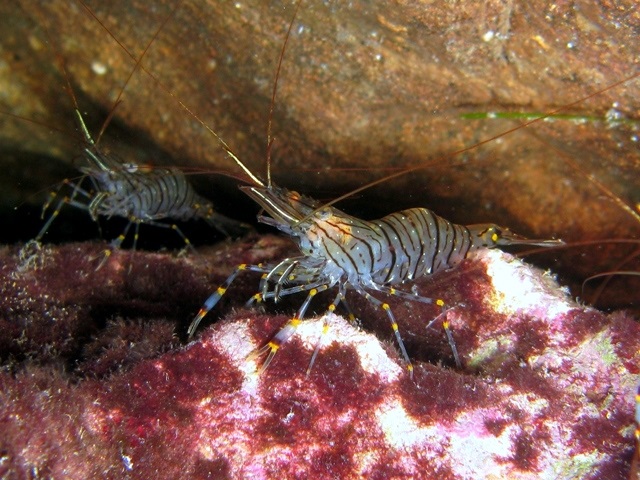
Photo: Etrusko25, Public domain, via Wikimedia Commons
| Latin Name | Palaemon serratus |
| Diet | Scavenges dead animals and seaweed, as well as hunting for worms and small fish. |
| Best time to see | August to October |
| Distribution | Common prawn can be found right around the UK, but are less common in north-east Scotland. |
| Habitat | Lives on rocky coasts and within sea grass beds, but especially favours rock crevices. |
| How to find | Rockpooling/Snorkelling/Diving. |
| Interesting fact | Female common prawns can lay up to 4,000 eggs at a time, which they carry around on their legs to protect from predators. |
Common Shrimp
Common shrimp are largely translucent, with mottled brown spots and markings over their bodies. They grow to around 5 cm on average, with very long antennae.
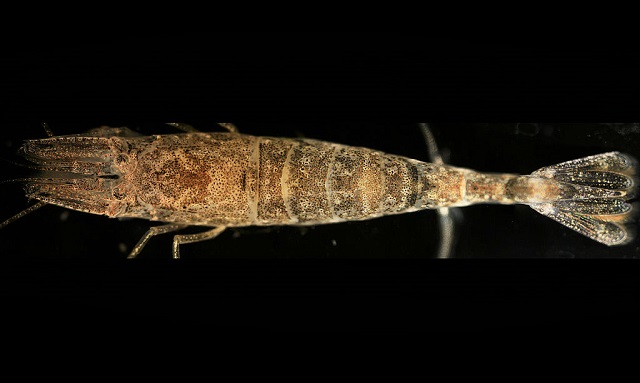
Photo: © Hans Hillewaert
| Latin Name | Crangon crangon |
| Diet | Feeds mainly on dead animals, as well as algae. |
| Best time to see | June to August. |
| Distribution | Common shrimp are found on all UK coasts. |
| Habitat | Shallow waters around estuaries are preferred, on sandy or muddy substrates. |
| How to find | Rockpooling/Snorkelling/Diving. |
| Interesting fact | To avoid predators such as birds and fish, common shrimp bury themselves in the sand during the day, with only their eyes and antennae sticking out. |
Northern Prawn
The northern prawn is a translucent, slightly pinkish colour with defined red streaks across its body. It generally grows to a length of 5 cm.
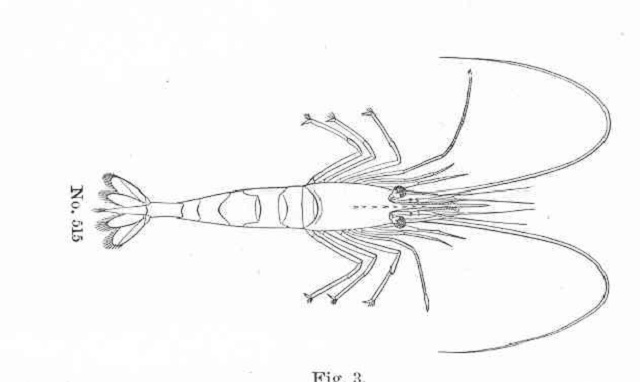
Image:James Henry Emerton, Public domain, via Wikimedia Commons
| Latin Name | Pandalus montagui |
| Diet | Scavenges dead animals and plant matter, as well as hunting for worms. |
| Best time to see | May to August. |
| Distribution | Northern prawns can be found around all UK coasts, but tend to be most common around Scotland. |
| Habitat | Lives on both sandy and rocky areas, to depths of around 300 m. |
| How to find | Rockpooling/Snorkelling/Diving. |
| Interesting fact | Many northern prawns start out life as male, but transition to female during their first year, before breeding over winter. |
Skeleton Shrimp
Skeleton shrimp are small shrimp, generally averaging 2 cm in length. They are very pale in colour, often with a brownish tinge.

Photo: © Hans Hillewaert
| Latin Name | Caprella linearis |
| Diet | Scavenges on dead animals, but will also catch plankton. |
| Best time to see | June to October. |
| Distribution | Skeleton shrimp are found on many parts of the UK coast. |
| Habitat | Usually lives around sea grass, sponges and seaweed, to depths of around 200 m. |
| How to find | Snorkelling/Diving. |
| Interesting fact | The skeleton shrimp is also known as the ‘ghost shrimp’ due to its eerily pale appearance. It is often seen in large numbers clinging to marine plants and algae. |
Gobies
Giant Goby
The giant goby is one of the largest goby species found in the UK, measuring about 25 cm in length. It is greyish in colour with mottled markings, and has a short tail.
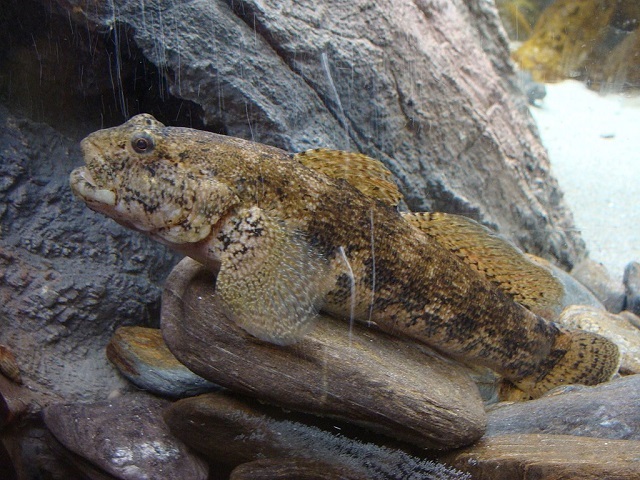
Photo: Fernando Losada Rodríguez, CC BY-SA 4.0, via Wikimedia Commons
| Latin Name | Gobius cobitis |
| Diet | Feeds on a range of foods, including worms, crustaceans, algae and other fish. |
| Best time to see | June to October. |
| Distribution | Giant gobies are restricted to southern England, particularly the south-west. |
| Habitat | Prefers large rock pool habitats on sheltered coasts, usually in rocky areas. |
| How to find | Rockpooling/Snorkelling. |
| Interesting fact | Female giant gobies lay thousands of eggs at a time, mainly in rock crevices. The males then guard the nests very attentively, defending them from predators. |
Painted Goby
Painted gobies are generally brown in colour, with dappled markings along the sides of their bodies. Males develop bluish dorsal fins during the breeding season. They average 5 cm in length.
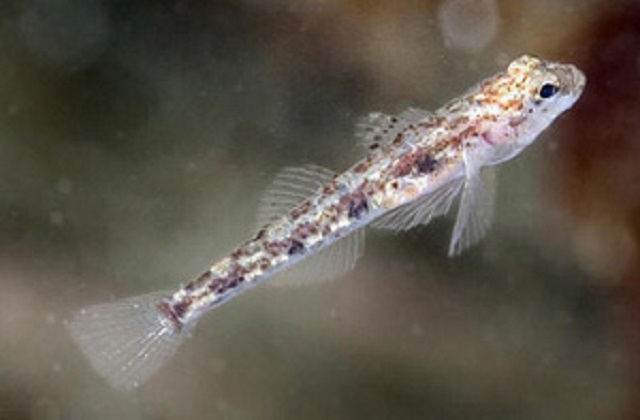
Photo: via Wikimedia Commons
| Latin Name | Pomatoschistus pictus |
| Diet | Generally feeds on small crustaceans such as copepods. |
| Best time to see | June to October. |
| Distribution | Painted gobies are widely distributed around the UK. |
| Habitat | Lives on gravel or sandy substrates in shallow waters, to depths of 50 m. |
| How to find | Rockpooling/Snorkelling/Diving. |
| Interesting fact | Painted gobies are surprisingly tame and will often approach people, hoping to feed on prey that divers or snorkellers disturb from amongst the sand. |
Rock Goby
The rock goby is generally light brown with mottled dark markings, although males almost turn black during the breeding season. Adults usually measure around 10 cm in length.
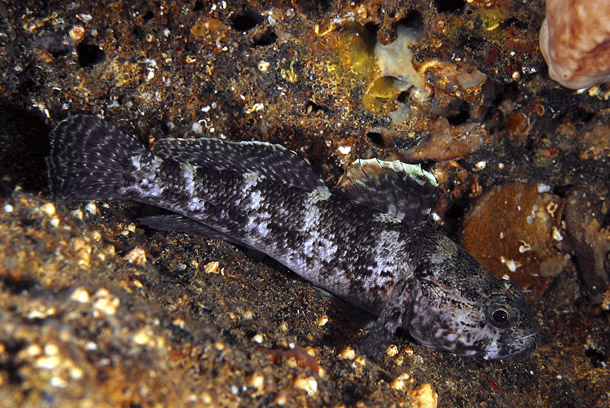
Photo: Stefano Guerrieri
| Latin Name | Gobius paganellus |
| Diet | Made up of prawns, worms and small crabs. |
| Best time to see | April to June. |
| Distribution | Rock gobies are found right around the UK coast, but are concentrated in western areas. |
| Habitat | As their name suggests, rock gobies prefer rocky habitats such as marine outcrops, to depths of 15 m. |
| How to find | Rockpooling/Snorkelling/Diving. |
| Interesting fact | The pelvic fins of rock gobies are fused together to form a sucker that helps them cling to rocks, preventing them from being washed away by large waves. |
Two-Spotted Goby
A distinctive fish, the two-spotted goby differs from other gobies in having its eyes on the sides of its head, rather than on top. It measures 5 cm in length and can be red or green, with males possessing two black spots.
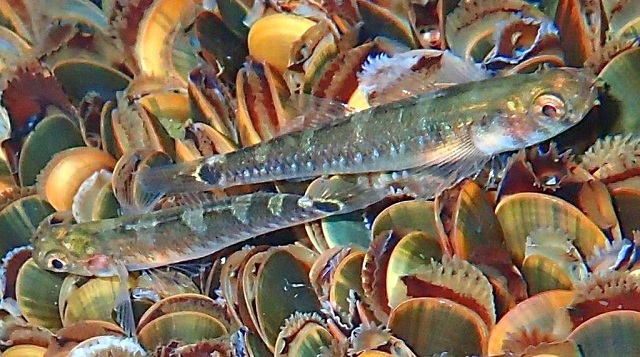
Photo: Magnefl, CC BY-SA 4.0, via Wikimedia Commons
| Latin Name | Gobiusculus flavescens |
| Diet | Feeds predominantly on zooplankton such as crustacean larvae. |
| Best time to see | April to June. |
| Distribution | Two-spotted gobies are widespread, found all around the UK coast. |
| Habitat | Usually lives in rockpools or in the shallow waters surrounding seaweed beds and seagrass. |
| How to find | Rockpooling/Snorkelling/Diving. |
| Interesting fact | Two-spotted gobies live in loose shoals in the water column, in stark contrast to the largely solitary, benthic-dwelling behaviour of most goby species. |
Blennies
Butterfly Blenny
The butterfly blenny has a tall dorsal fin that extends down the length of the body. It averages 14 cm in length and is brownish-grey, with vertical dark barring. It has small head tentacles.

Etrusko25, CC BY-SA 3.0, via Wikimedia Commons
| Latin Name | Blennius ocellaris |
| Diet | Filters plankton from the water, but will alsoMainly small invertebrates such as crabs and worms. feed on dead animals and plant matter. |
| Best time to see | April to July. |
| Distribution | Butterfly blennies are distributed around southern UK coasts, although large numbers can be found in the Irish Sea. |
| Habitat | Lives on rocky shores where seaweed is abundant, down to depths of around 200 m. |
| How to find | Rockpooling/Snorkelling/Diving. |
| Interesting fact | When living in more open areas, butterfly blennies often use shells or discarded cans as homes – shelters which they also use to protect their eggs. |
Tompot Blenny
Tompot blennies are orange-brown with vertical dark barring. They are the largest blennies found in the UK, measuring about 20 cm in length. Distinctive frilled tentacles crown their heads.
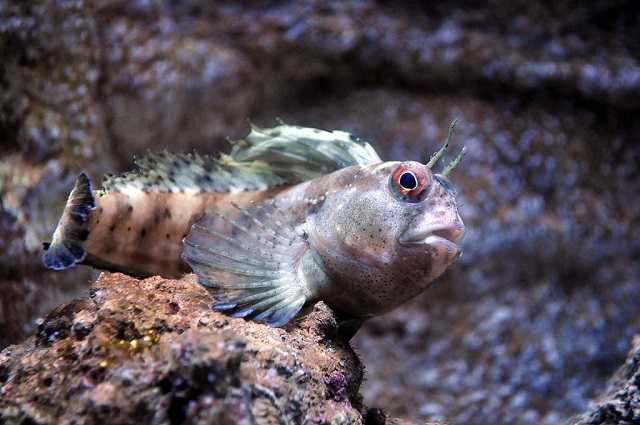
Photo: © Citron
| Latin Name | Parablennius gattorugine |
| Diet | Made up of sea anemones, prawns and other small crustaceans. |
| Best time to see | April to July. |
| Distribution | Tompot blennies are predominantly found in the south-west of the UK, and are absent from the North Sea. |
| Habitat | Rocky areas in inshore waters are preferred, to depths of around 50 m. Rock crevices and holes are used as shelters. |
| How to find | Rockpooling/Snorkelling/Diving. |
| Interesting fact | Tompot blennies are very curious fish and they will often investigate divers or snorkellers who come across the hidey-holes where they live. |
Shanny
The shanny is a medium-sized blenny, averaging 10 cm in length. It can be distinguished from other blennies by lacking head tentacles, and is usually brown with dark blotches.

Photo Gilles San Martin, CC BY-SA 3.0, via Wikimedia Commons
| Latin Name | Lipophrys pholis |
| Diet | Prefers small invertebrates such as barnacles and snails, but will also eat algae. |
| Best time to see | April to July. |
| Distribution | Shannies are very common and are found right around the UK coast. |
| Habitat | Mainly seen amongst rockpools and shallow waters, particularly on rocky coastlines. |
| How to find | Rockpooling/Snorkelling. |
| Interesting fact | The shanny is also known as the ‘sea frog’ for its ability to breathe air. It can survive for short periods out of the water – an adaptation which helps it thrive in its changeable rockpool habitats. |
Wrasse
Ballan Wrasse
Ballan wrasse are heavy-bodied fish which grow to around 30 cm long on average. They have long dorsal fins and are extremely variable in colour, usually seen in oranges or greens with pale spots.
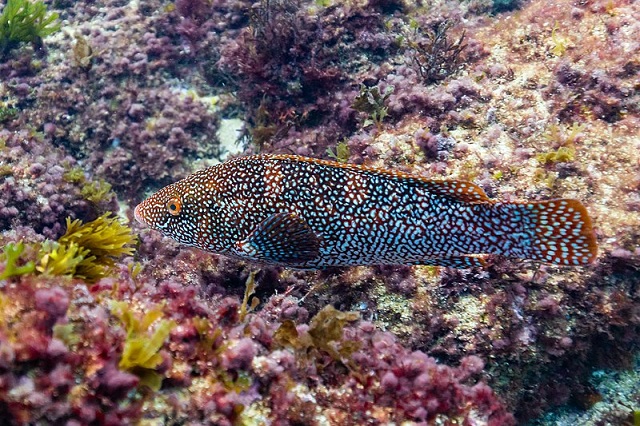
Photo: Diego Delso, CC BY-SA 4.0, via Wikimedia Commons
| Latin Name | Labrus bergylta |
| Diet | Mainly molluscs and barnacles, although crabs are also eaten. |
| Best time to see | May to August. |
| Distribution | Ballan wrasse are common right around the UK coast. |
| Habitat | Shallow coastal waters are preferred, often around areas with an abundance of rocks and seaweed. They are found to depths of 50 m. |
| How to find | Snorkelling/Diving. |
| Interesting fact | Ballan wrasse are all born female, but a few transition to male between the ages of 4 and 14 years old. The oldest individuals can live for as many as 30 years. |
Corkwing Wrasse
The corkwing wrasse is variable in colour, but females are typical greenish-brown and males are a mixture of blue and orange, becoming striking in summer. They average 15 cm in length and can be distinguished by having a black spot in the middle of the tail.
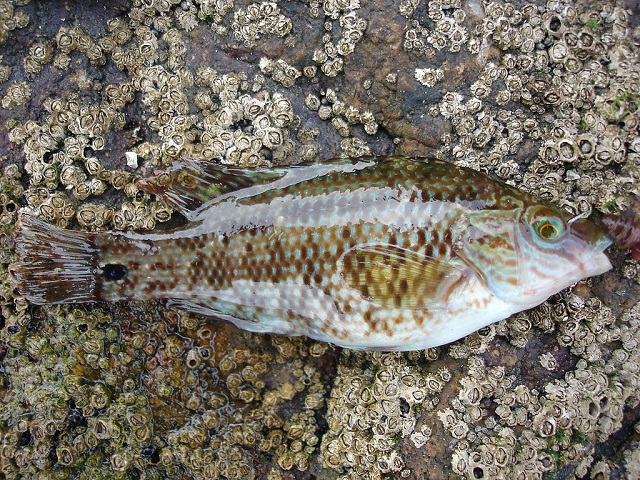
Photo: NicoDesSables, CC BY-SA 3.0, via Wikimedia Commons
| Latin Name | Symphodus melops |
| Diet | Molluscs and copepods are favoured, although other small crustaceans are also consumed. |
| Best time to see | April to July. |
| Distribution | Corkwing wrasse are found on most UK coasts, but are more common in south-west England. |
| Habitat | Rocky shores with an abundance of seaweed or eelgrass are preferred, to depths of around 50 m. |
| How to find | Snorkelling/Diving. |
| Interesting fact | Some male corkwing wrasse utilise a sneaky breeding strategy, where they dull down their colours to fool male ‘nest guarders’ into thinking they are female. By doing so, the sneaker male can enter the nest and fertilise the eggs himself. |
Cuckoo Wrasse
Cuckoo wrasse are slim, brightly-coloured wrasse with pointed snouts. They average 25 cm in length, with males possessing electric blue and orange markings, and females coloured a pale pink.
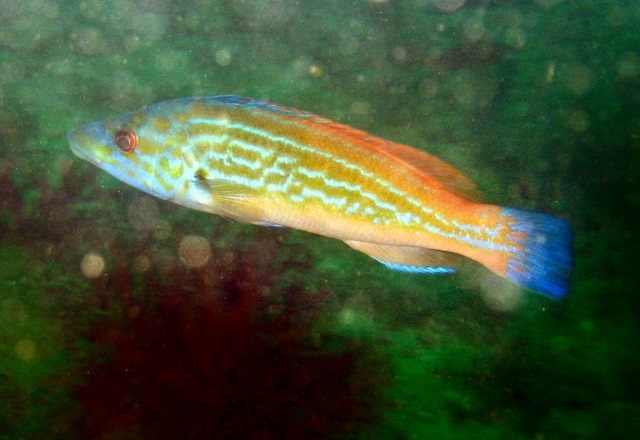
Photo: Aharrygill at English Wikipedia, CC BY-SA 3.0, via Wikimedia Commons
| Latin Name | Labrus mixtus |
| Diet | Mainly molluscs such as limpets and mussels, supplemented by small crustaceans. |
| Best time to see | June to August |
| Distribution | Cuckoo wrasse can be found around all UK coasts, however they are far more common on western shores. |
| Habitat | Rocky areas and hard ground in shallow regions are favoured, to depths of around 100 m. |
| How to find | Snorkelling/Diving. |
| Interesting fact | Cuckoo wrasse get their name from Cornish fisherman, who associated their bright blue markings with bluebells – which in the Cornish language are known as ‘cuckoo flowers’. |
Flatfish
Common Topknot
The common topknot is a round-bodied flatfish with a small tail and fins running right around the body. It averages around 16 cm in length and is generally marbled brown with dark blotches.

Photo: Conty, CC BY 3.0, via Wikimedia Commons
| Latin Name | Zeugopterus punctatus |
| Diet | Feeds on small crustaceans and other fish. |
| Best time to see | June to September. |
| Distribution | Distributed throughout the UK’s waters but more common in the west. |
| Habitat | Rocky shores are preferred, especially around areas with lots of stones, rocks or seaweed beds. |
| How to find | Snorkelling/Diving. |
| Interesting fact | Common topknots have an extraordinary ability to cling upside down to overhanging rocks. They do this by using their frilled fins to grip on to tiny ridges and imperfections in the rock. |
Dab
The dab is a small flatfish, averaging 20 cm in length. It is pale brown with a series of darker blotches and spots, and the margins of the body are fringed with two gently curving fins.
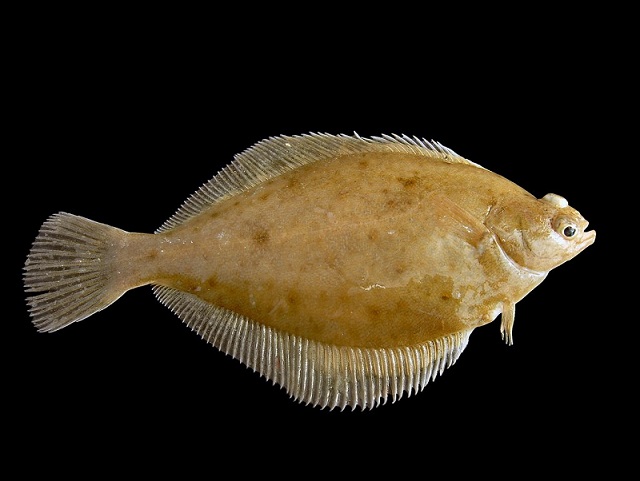
Photo: © Hans Hillewaert
| Latin Name | Limanda limanda |
| Diet | Varied diet includes small crustaceans such as amphipods, as well as molluscs and worms. |
| Best time to see | June to September. |
| Distribution | The dab is one of the most common fish in the UK, found around all coasts. |
| Habitat | Can be seen bottom-dwelling on sandy shores, generally to depths of around 50 m. |
| How to find | Rockpooling/Snorkelling/Diving. |
| Interesting fact | The dab has a very characteristic feeding method, whereby it raises the front half of its body off the substrate and waits for prey to stray near, before striking down hard with a sharp bite. |
European Flounder
European flounders are oval-shaped flatfish with long, square-cut tails. They average around 30 cm in length and are brown to grey in colour, often with faint orange spots.
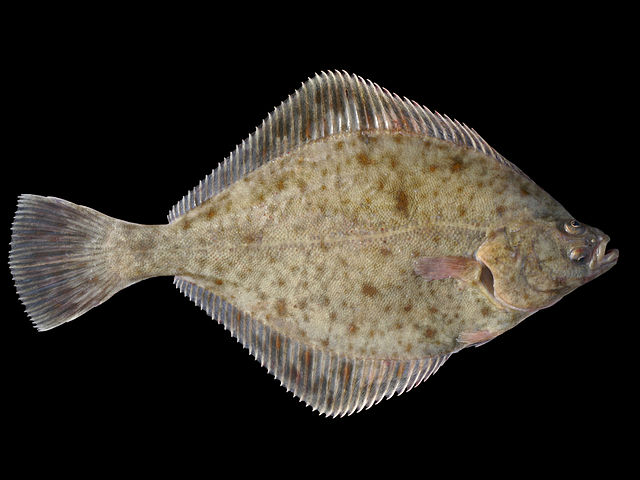
Photo: © Hans Hillewaert
| Latin Name | Platichthys flesus |
| Diet | Mainly feeds on molluscs, but will also prey on worms, shrimp and smaller fish. |
| Best time to see | June to September. |
| Distribution | The European flounder can be found around all UK coastlines, especially in the east. |
| Habitat | Lives on the seabed in sandy or muddy areas, generally to depths of around 100 m. |
| How to find | Snorkelling/Diving. |
| Interesting fact | Like many other flatfish, European flounders experience eye-migration, where the eyes shift to one side of the body as the fish becomes flat during early development. Depending on which side the eyes go, the fish are known as either right-handed or left-handed. |
Lemon Sole
Lemon soles are oval-shaped flatfish with long fins that extend right to the base of the tails. They average 30 cm in length and are usually light brown, with darker spots and blotches.
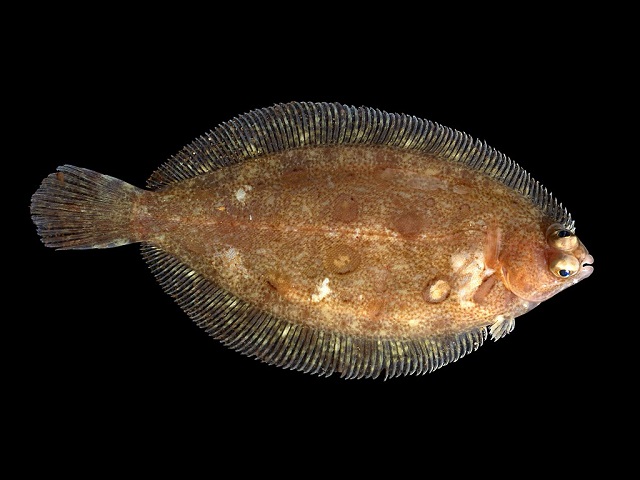
Photo: © Hans Hillewaert
| Latin Name | Microstomus kitt |
| Diet | Preys on marine worms, prawns and shellfish, as well as small crabs. |
| Best time to see | June to September. |
| Distribution | Lemon soles are most commonly found in the English Channel and Irish Sea, although they can be seen anywhere on the UK coast. |
| Habitat | Stony bottoms in shallow waters are preferred, to depths of around 200 m. |
| How to find | Snorkelling/Diving. |
| Interesting fact | Lemon soles are similar to other flatfish in that they can rapidly change the colour and pattern of their bodies to match their environment. They do this using cells known as chromatophores. |
Plaice
The plaice is a large, oval-shaped flatfish that measures around 40 cm in length on average. It is usually dark green or brown, with distinctive orange spots all over the body.
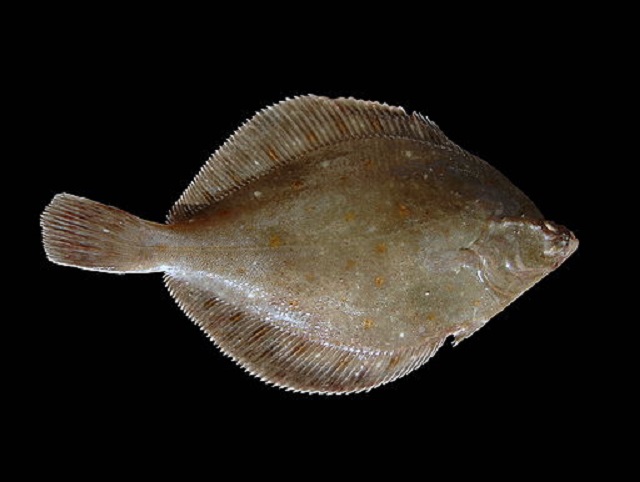
Photo: © Hans Hillewaert
| Latin Name | Pleuronectes platessa |
| Diet | Preys mainly on marine worms, small crustaceans and molluscs. |
| Best time to see | June to September. |
| Distribution | Plaice can generally be found anywhere on the UK coast. |
| Habitat | Sandy bottoms are preferred, along with shingle or muddy substrate. They occur between 0 and 200 m, although young fish are often seen in tidal pools. |
| How to find | Rockpooling/Snorkelling/Diving |
| Interesting fact | Plaice usually spawn early in the year, with females producing up to half a million eggs in one season. Despite this, only a tiny fraction ever survive to adulthood. |
Sea Scorpions
Long-Spined Sea Scorpion
The long-spined sea scorpion is a small fish with a large head and tapering body, averaging 13 cm in length. It has barbs in each corner of the mouth and is usually green or grey, with mottled blotches.
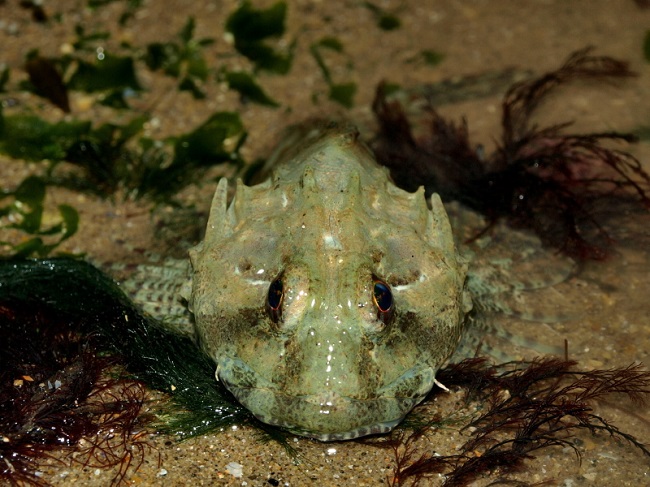
Photo: Yashca, CC BY-SA 3.0, via Wikimedia Commons
| Latin Name | Taurulus bubalis |
| Diet | Feeds on prawns and mussels, but is also a fierce predator of small fish such as gobies and blennies. |
| Best time to see | July to October. |
| Distribution | Long-spined sea scorpions can be found right around the UK’s waters. |
| Habitat | Often seen in shallow waters around rocky areas, or amongst seaweed, to depths of about 30 m. |
| How to find | Rockpooling/Snorkelling/Diving. |
| Interesting fact | Long-spined sea scorpions – like many species in their family – lack swim bladders. This means they sink as soon as they stop swimming. |
Lumpsucker
Lumpsuckers – hence their name – are lumpy, ball-shaped fish with knobbly backs. They average about 40 cm in length and are usually greyish-blue in colour, although males turn orange during the breeding season.

Photo: Steven G. Johnson, CC BY-SA 3.0, via Wikimedia Commons
| Latin Name | Cyclopterus lumpus |
| Diet | Made up of zooplankton, along with fish eggs and small crustaceans. |
| Best time to see | February to May. |
| Distribution | Lumpsuckers are distributed throughout the UK, but are less common in the south-east of England. |
| Habitat | Adults inhabit deep waters for much of the year, but young lumpsuckers live in tidal pools or around floating seaweed clumps. |
| How to find | Rockpooling/Snorkelling/Diving. |
| Interesting fact | The pelvic fins of lumpsuckers are fused to form a sucker. As the eggs are often laid in the rough surf zone, males use their suckers to cling to rocks as they guard the nests. |
Montagu’s Sea Snail
Montagu’s sea snail is a tadpole-shaped fish with a long tail. It averages 5 cm in length and is usually olive-brown in colour, although some individuals may appear orange.
| Latin Name | Liparis montagui |
| Diet | Mainly small crustaceans such as shrimp and amphipods. |
| Best time to see | June to September. |
| Distribution | Montagu’s sea snail can be found throughout the UK’s coastal waters. |
| Habitat | Shallow waters in rocky areas are preferred, especially around seaweed beds. Usually seen down to depths of 30 m. |
| How to find | Rockpooling/Snorkelling/Diving. |
| Interesting fact | Unlike most fish, Montagu’s sea snail does not have scales. Instead, its body is covered in smooth, slimy skin, which is likely how it got its name. |
Short-Spined Sea Scorpion
Short-spined sea scorpions have large heads and squat bodies, which usually measure around 20 cm in length. Although variable in colour, they tend to be greyish-brown with mottled, dark markings.
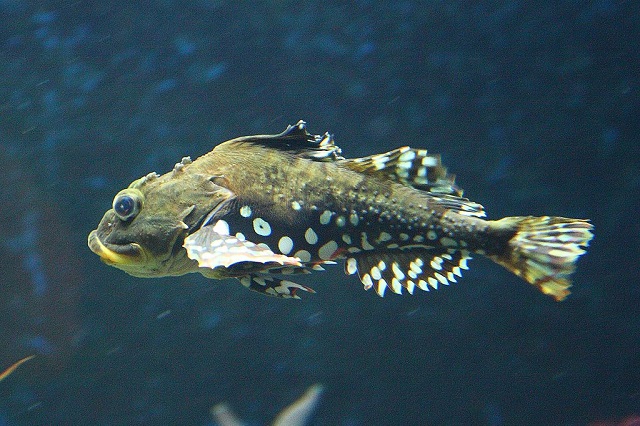
Photo: Cephas, CC BY-SA 3.0, via Wikimedia Commons
| Latin Name | Myoxocephalus scorpius |
| Diet | Feeds on smaller fish, as well as crustaceans such as crabs and shrimp. |
| Best time to see | May to August. |
| Distribution | Short-spined sea scorpions can be found right around the UK coast, but are less common in north-west Scotland. |
| Habitat | Living to depths of 50 m, this species resides in rocky habitats with areas of sand or mud. |
| How to find | Rockpooling/Snorkelling/Diving. |
| Interesting fact | As a species adapted to cold waters, the short-spined sea scorpion has anti-freeze proteins in its body, which allow it to survive in Arctic waters. |
Streaked Gurnard
The streaked gurnard is a narrow fish with very large, fan-like pectoral fins. It averages 20 cm in length and is usually reddish-brown with dark blotches.

Photo: Roberto Pillon, CC BY 3.0, via Wikimedia Commons
| Latin Name | Chelidonichthys lastoviza |
| Diet | Small crustaceans such as crabs and shrimp are its primary food. |
| Best time to see | July to October. |
| Distribution | Streaked gurnards can be seen right around the UK, although they are more common in southern areas such as the English Channel. |
| Habitat | Often found on sandy or rocky bottoms in shallow waters, although can live to depths of 150 m. |
| How to find | Snorkelling/Diving. |
| Interesting fact | Streaked gurnards possess a pair of long spines just beneath their gills. These are equipped with sensory organs which are used to feel around the seafloor for potential prey. |
Tub Gurnard
As the largest gurnard species in the UK, the tub gurnard averages 35 cm in length. It is usually reddish in colour and adult individuals can be identified by having striking blue pectoral fins.
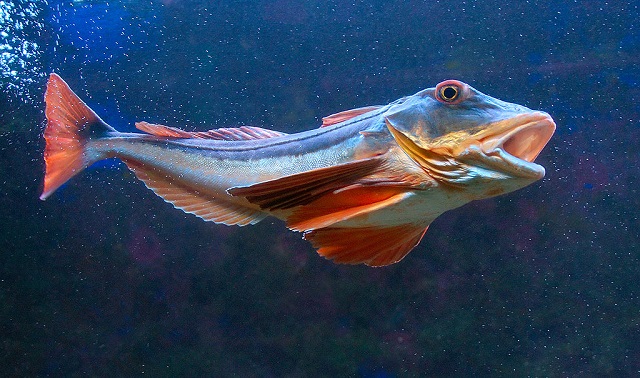
Photo: I, Luc Viatour, CC BY-SA 3.0, via Wikimedia Commonsxxxxx
| Latin Name | Chelidonichthys lucernus |
| Diet | Mainly preys on small crustaceans such as crabs, but will also catch other fish. |
| Best time to see | June to September. |
| Distribution | Tub gurnards are distributed throughout the UK’s waters. |
| Habitat | Can be seen in a variety of habitats but is mainly found on the sea floor. Young fish live in shallow areas, while adults venture to depths of 300 m. |
| How to find | Snorkelling/Diving. |
| Interesting fact | Tub gurnards – like others in their genus – have finger-like extensions on their pectoral fins. These are used to detect prey, as well as functioning similarly to legs. |
Pipefish & Seahorses
Long-Snouted Seahorse
The long-snouted seahorse has a slender body and long snout, and measures 12 cm in length on average. It is usually yellowish-green with white spots and fleshy protuberances along its back.
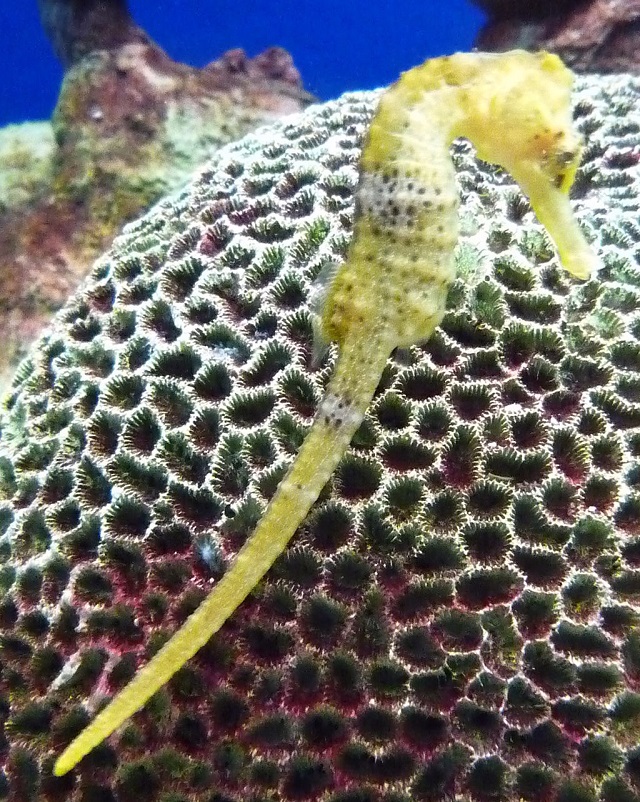
Photo: FASTILY, CC BY-SA 3.0, via Wikimedia Commons
| Latin Name | Hippocampus guttulatus |
| Diet | Small shrimp and plankton are favoured, although it will also feed on fish eggs. |
| Best time to see | July to September. |
| Distribution | Long-snouted seahorses are restricted to the southern coasts of England and Wales. |
| Habitat | A shallow water species, it can be found around seagrasses and algal beds in mixed habitats. It generally occurs to depths of 20 m. |
| How to find | Snorkelling/Diving. |
| Interesting fact | As with other seahorses, it is the male long-snouted seahorse that gives birth to the young. The female transfers her eggs to him, which he then self-fertilises and broods in a special pouch. |
Short-Snouted Seahorse
Short-snouted seahorses have small, upturned snouts and smooth skin, lacking the manes of other seahorse species. They average 12 cm in length and their colour varies from light brown to purple.

Photo: © Hans Hillewaert
| Latin Name | Hippocampus hippocampus |
| Diet | Predominantly feeds on shrimp, along with other small crustaceans. |
| Best time to see | June to September. |
| Distribution | Short-snouted seahorses favour warmer waters and can only be found on the southern coast of England. |
| Habitat | Shallow, muddy waters are preferred, especially around seaweed and seagrasses. Generally lives to depths of 50 m. |
| How to find | Snorkelling/Diving. |
| Interesting fact | Being a relatively poor swimmer, the short-snouted seahorse relies on its prehensile tail to hold on to grasses or seaweed, ensuring it is not carried away on the tide. |
Snake Pipefish
The snake pipefish is very long and slender, with a body that averages 28 cm in length. It lacks pectoral fins and anal fins, and is usually pale brown or yellowish-green in colour.
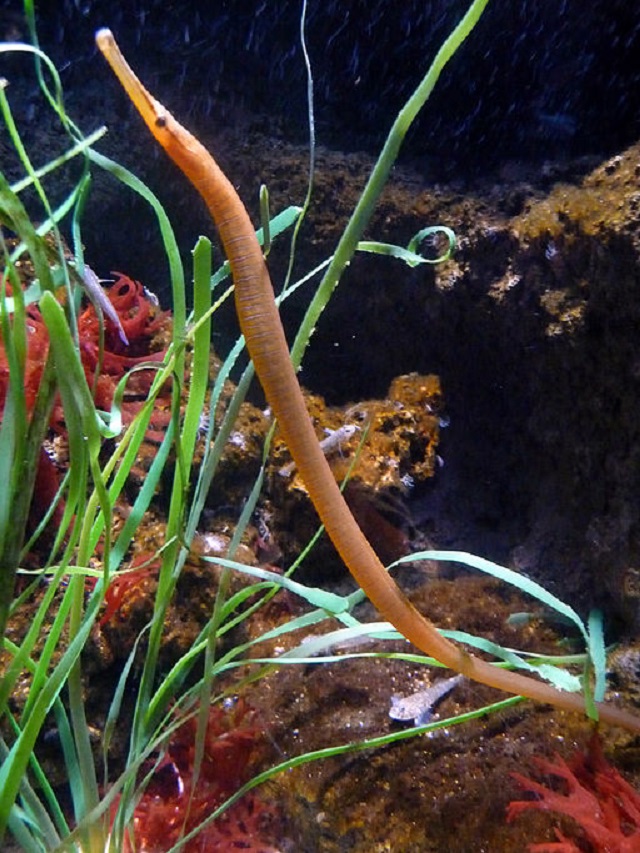
Photo: © Citron /
| Latin Name | Entelurus aequoreus |
| Diet | Generally prefers to feed on small crustaceans and fish larvae. |
| Best time to see | June to September. |
| Distribution | Although uncommon, snake pipefish can be found right around the UK coastline. |
| Habitat | Lives in shallow waters, between 10 and 100 m depths. Areas of kelp and seagrass are preferred, in both sandy and rocky habitats. |
| How to find | Snorkelling/Diving. |
| Interesting fact | Marine birds sometimes feed snake pipefish to their chicks, in place of sand eels. However, pipefish have hard, indigestible bodies and many chicks can choke while trying to eat them. |
Worm Pipefish
The worm pipefish has a smooth, slender body with an upturned snout. It measures around 12 cm in length and is usually olive-coloured, with pale face markings.
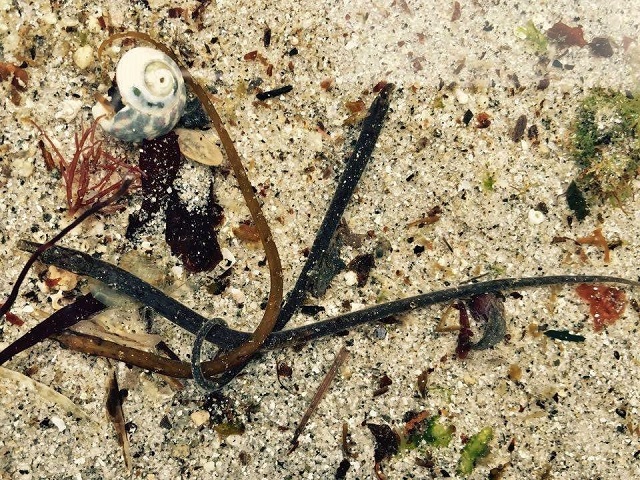
Photo: Gabrielle Ringot, CC BY-SA 4.0, via Wikimedia Commons
| Latin Name | Nerophis lumbriciformis |
| Diet | Mainly feeds on small crustaceans such as copepods and amphipods. |
| Best time to see | June to September. |
| Distribution | Worm pipefish are most common in south-west England and Wales, although they are also distributed as far north as western Scotland. |
| Habitat | Often seen on the shoreline, residing amongst seaweed or underneath boulders. They live to depths of 30 m. |
| How to find | Rockpooling/Snorkelling/Diving. |
| Interesting fact | As with seahorses, worm pipefish males carry and give birth to the young. Females attract males by becoming brightly coloured and engaging in short courtship dances. |
Clingfish
Shore Clingfish
The shore clingfish is unusual in appearance, with a flattened body, triangular head and ‘duck-billed’ snout. It averages 5 cm in length and is usually reddish-brown in colour.
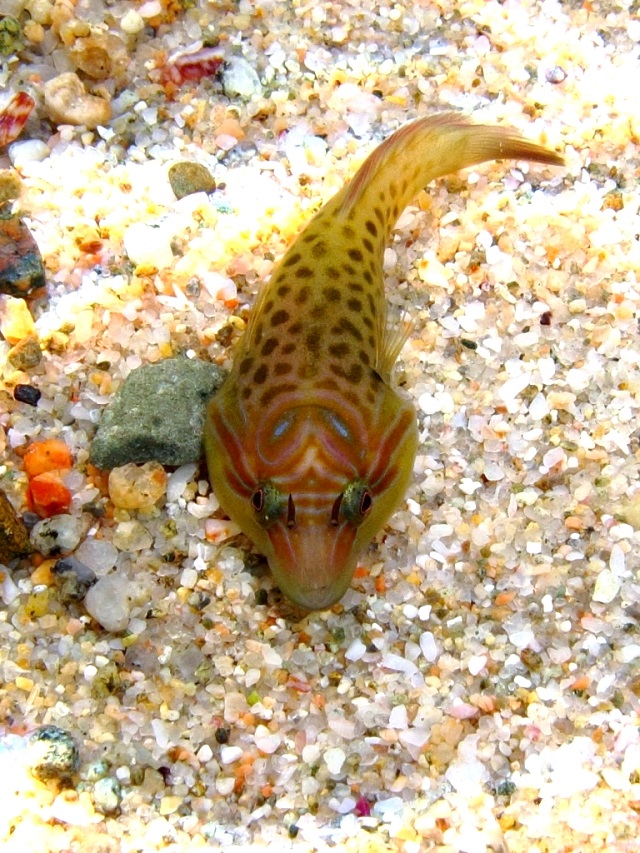
Photo: Roberto Pillon, CC BY 3.0, via Wikimedia Commons
| Latin Name | Lepadogaster lepadogaster |
| Diet | Dead organic matter is preferred, although live crustaceans will also be eaten. |
| Best time to see | June to September. |
| Distribution | Shore clingfish are mainly found in south-west England, Wales and western Scotland. |
| Habitat | Often seen among rockpools and seaweed-covered shores, especially under boulders. |
| How to find | Rockpooling/Snorkelling. |
| Interesting fact | Shore clingfish are also known as Cornish suckers, in reference to their pelvic fins which are fused to form a sucking disc. This disc is used to cling to the undersides of rocks. |
Two-Spotted Clingfish
The two-spotted clingfish is a small, tadpole-shaped fish with a triangular head and a body that measures around 4 cm long. It is often reddish in colour with vibrant spots.
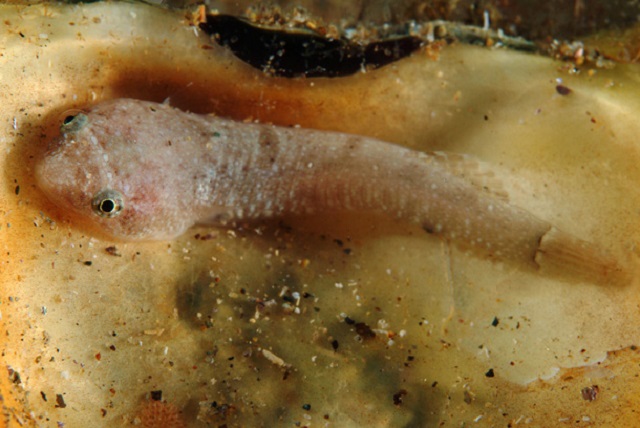
Photo: Etrusko25, Public domain, via Wikimedia Commons
| Latin Name | Diplecogaster bimaculata |
| Diet | Feeds mainly on small crustaceans such as copepods. |
| Best time to see | June to September. |
| Distribution | Two-spotted clingfish are found around the UK, but are more common in western areas and are rare in the North Sea. |
| Habitat | Rocky or stony habitats are favoured, as well as areas of seagrass. It usually lives to depths of 55 m. |
| How to find | Snorkelling/Diving. |
| Interesting fact | Two-spotted clingfish use their small stature to hide among abandoned snail shells. They also lay their eggs within these structures too, which the parents guard fiercely. |
Goatfish
Red Mullet
Red mullets are coloured red or brown, often with a distinctive red stripe down each side of the body. They can be identified by their white chin barbels, and average 25 cm in length.
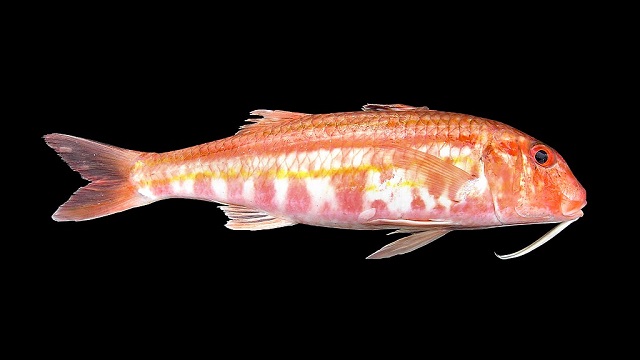
Photo: © Hans Hillewaert
| Latin Name | Mullus surmuletus |
| Diet | Includes a variety of marine animals, such as crustaceans, worms and molluscs. |
| Best time to see | June to September. |
| Distribution | Red mullets are predominantly found on south-western coasts of the UK, although some migrate into the North Sea. |
| Habitat | Often seen on the seafloor, in sandy estuaries or on muddy bottoms. It lives to depths of around 90 m. |
| How to find | Snorkelling/Diving. |
| Interesting fact | When red mullets live in groups, they will signal to each other when danger is near by raising their front dorsal fins. |
Sand Eels & Weevers
Lesser Weever Fish
The lesser weever fish has a stout body, with an upturned mouth and eyes situated on top of its head. It averages 13 cm in length and is sandy coloured, with venomous dorsal spines.
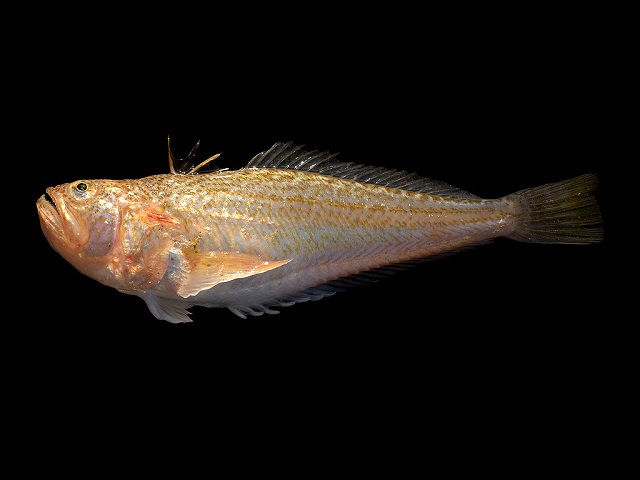
Photo: © Hans Hillewaert
| Latin Name | Echiichthys vipera |
| Diet | Comprised largely of small crustaceans such as amphipods and shrimp. |
| Best time to see | June to October. |
| Distribution | Lesser weever fish are widely distributed around England and Wales, but are less common around Scotland and Northern Ireland. |
| Habitat | Open, sandy areas are preferred, mainly in shallow waters. |
| How to find | Snorkelling/Diving. |
| Interesting fact | Lesser weever fish tend to bury themselves in the sand with their venomous spines pointing upwards. For this reason, they are dangerous to beach-goers, with stings being very painful. |
Lesser Sand Eel
Lesser sand eels are long and thin, with very pointed jaws. They average around 14 cm in length and are silvery in colour, with a green tinge on their backs.
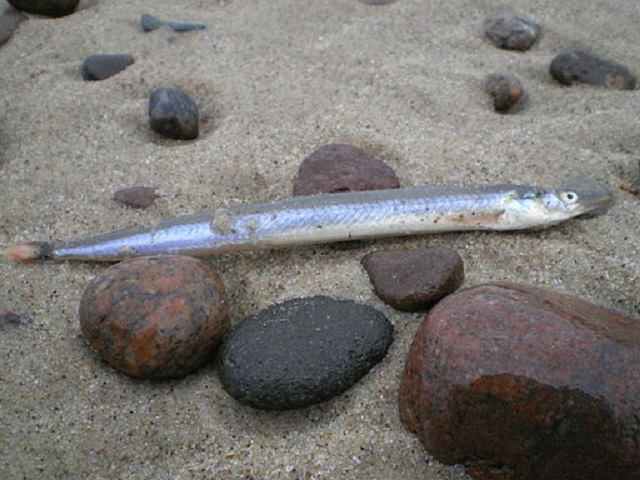
Photo: TomiUSM, Public domain, via Wikimedia Commons
| Latin Name | Ammodytes tobianus |
| Diet | Zooplankton, fish larvae and small crustaceans. |
| Best time to see | June to September. |
| Distribution | Lesser sand eels are distributed widely around the UK. |
| Habitat | Mainly see along clean, sandy shores, from the shoreline down to depths of around 30 m. |
| How to find | Rockpooling/Snorkelling/Diving. |
| Interesting fact | Lesser sand eels live in small schools and use their sandy habitats to evade predators. At the first sign of danger, they will bury down into the sand and wait until it is safe to come out. |
Sea Breams
Black Sea Bream
Black sea breams are large fish, measuring 37 cm in length. They are oval in shape and silvery in colour, occasionally with dark vertical bands or small yellow stripes.
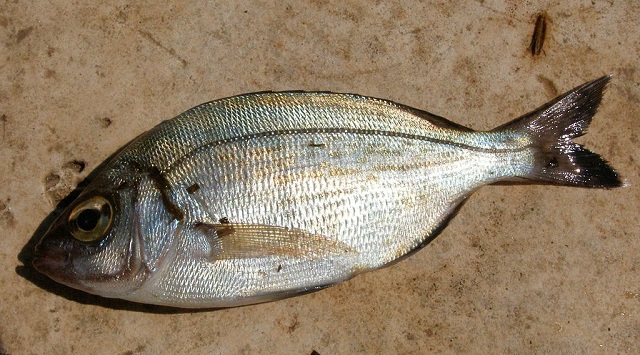
Photo: Gronk, CC BY-SA 3.0, via Wikimedia Commons
| Latin Name | Spondyliosoma cantharus |
| Diet | As an omnivore, it feeds on seaweed and small invertebrates such as crustaceans. |
| Best time to see | June to September. |
| Distribution | Black sea breams are largely distributed around south-west England and Wales, although some can be found around Northern Ireland and Scotland. |
| Habitat | Often seen in seagrass beds over sandy bottoms, living to depths of around 300 m. |
| How to find | Snorkelling/Diving. |
| Interesting fact | During their spring breeding season, male black sea breams excavate sandy nests using their tails. The females lay their eggs within the nest, which the male then guards until hatching occurs. |
Basses
European Sea Bass
European sea basses are silvery-grey in colour, often with a green tinge. They have two distinct dorsal fins, the first of which is spiny in appearance. 50 cm is a typical length.
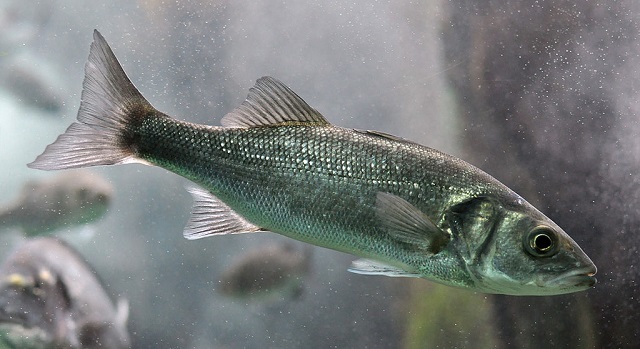
Photo: © Citron
| Latin Name | Dicentrarchus labrax |
| Diet | Preys on smaller fish, as well as crustaceans and small squid. |
| Best time to see | March to June. |
| Distribution | European sea basses are mainly distributed around England and Wales, especially on southern coastlines. |
| Habitat | Prefers shallow coastal waters, particularly around estuaries and lagoons. May also move into large rivers. |
| How to find | Snorkelling/Diving. |
| Interesting fact | Young European sea bass tend to school together in sheltered inshore waters. They mature slowly, becoming adults at around 4 – 8 years of age, at which point they venture further offshore. |
Mackerel
Atlantic Mackerel
Atlantic mackerels can be identified by their metallic, blue-green colouration and dark stripes. They are streamlined in shape and average 30 cm in length.
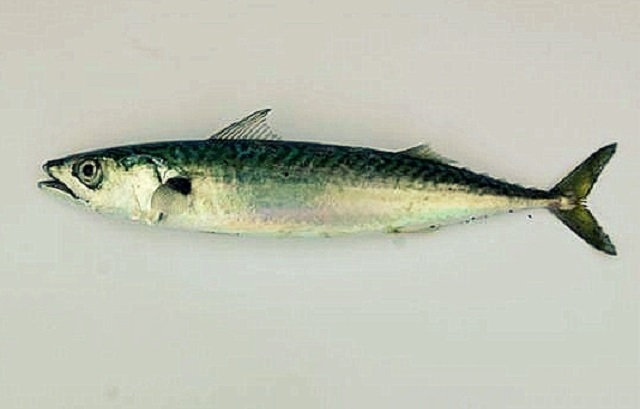
| Latin Name | Scomber scombrus |
| Diet | Prefers to feed on zooplankton and small fish such as sand eels. |
| Best time to see | June to September. |
| Distribution | Atlantic mackerels can be found right around the UK coast. |
| Habitat | Spends the summer months in inshore waters, in varied habitats. Moves to deeper waters over the edges of continental shelves during winter. |
| How to find | Snorkelling/Diving. |
| Interesting fact | Atlantic mackerels live in large shoals, with the largest measuring 9 km long and 4 km wide. As such, they are a prime target for big marine predators. |
Codfishes
Atlantic Cod
As a large, stocky fish, the Atlantic cod grows to 68 cm in length on average. It is mottled brown in colour, with darker spots and a distinctive short chin barbel.
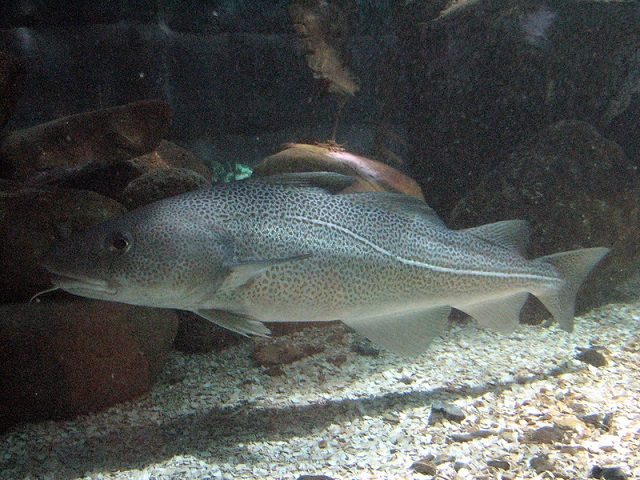
Atlantic Cod Fish Swimming by Glen Bowman
| Latin Name | Gadus morhua |
| Diet | Young individuals feed on copepods, whereas adults are predators of smaller fish. |
| Best time to see | June to September. |
| Distribution | Atlantic cod are widely distributed around UK coastlines and are found almost everywhere. |
| Habitat | Shallow, inshore waters are favoured during summer, while deeper continental shelf regions are inhabited during winter. |
| How to find | Snorkelling/Diving. |
| Interesting fact | Atlantic cods can produce as many as 6 million eggs at a time, which drift on ocean currents for 12 days before hatching. Despite this, the species is extensively overfished in some regions. |
Atlantic Pollack
Atlantic pollacks are sleek fish with three distinct dorsal fins and protruding lower jaws. They average 58 cm in length and have brown backs and yellowish sides.

Photo: © Citron
| Latin Name | Pollachius pollachius |
| Diet | Feeds on deep sea prawns and smaller fish. |
| Best time to see | March to June. |
| Distribution | Atlantic pollacks occur around all UK coasts, especially in the west. |
| Habitat | Mainly found to depths of 100 m, around rocky habitats and kelp forest. |
| How to find | Snorkelling/Diving. |
| Interesting fact | Atlantic pollacks can often be seen resting on the seabed, where they patiently watch shoals of fish swimming above. Every so often, they dart upwards and snatch one fish from the shoal. |
Common Ling
As the largest fish in the cod family, the common ling averages 83 cm in length. It has an elongated appearance and a rounded tail, and is generally greenish-brown in colour.

Photo: F Lamiot, CC BY-SA 3.0, via Wikimedia Commons
| Latin Name | Molva molva |
| Diet | Primarily feeds on fish such as Atlantic cod, as well as crustaceans. |
| Best time to see | June to September. |
| Distribution | Common lings can be found on coasts all around the UK. |
| Habitat | Prefers rocky areas and is often seen hiding among wrecks, to depths of around 600 m. |
| How to find | Diving |
| Interesting fact | Due to their solitary, secretive nature, common lings are rarely seen. Their elongate appearance and habit of hiding in crevices also means they are frequently mistaken for eels. |
Poor Cod
The poor cod is a small fish species, measuring around 18 cm in length. It is reddish-brown with three dorsal fins and a distinctive chin barbel.

Photo: Gervais et Boulart, Public domain, via Wikimedia Commons
| Latin Name | Trisopterus minutus |
| Diet | Prefers to feed on crustaceans such as shrimp and crabs, as well as smaller fish. |
| Best time to see | June to September. |
| Distribution | Poor cods are distributed throughout the UK’s waters. |
| Habitat | Mainly seen on sandy or muddy shores in shallow waters. Larger individuals reside in wrecks or rocky areas to depths of 300 m. |
| How to find | Snorkelling/Diving. |
| Interesting fact | Due to the poor cod’s size, it is not sought after by fisherman and has little commercial value – a characteristic which gives it its common name. |
Pouting
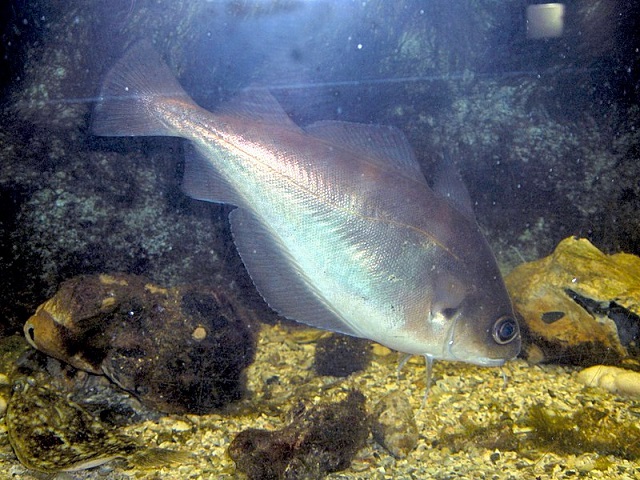
The pouting is a small, diamond-shaped fish that averages 25 cm in length. It is copper-coloured, with 3 or 4 vertical pale bands and a small chin barbel.
| Latin Name | Trisopterus luscus |
| Diet | Scavenges on the seabed for molluscs, worms and dead fish. |
| Best time to see | June to September. |
| Distribution | The pouting can be found on coastlines right around the UK, although it is most common in the south. |
| Habitat | Generally occurs to depths of 300 m, but favours shallow waters in mixed rock and sand habitats. |
| How to find | Snorkelling/Diving. |
| Interesting fact | Poutings are frequently encountered in and around wrecks, where they shelter in small schools from larger predatory fish such as cod and bass. |
Saithe
The saithe has a dark-green back with silver sides and a very prominent lateral line. It measures 54 cm in length and is relatively streamlined in shape.
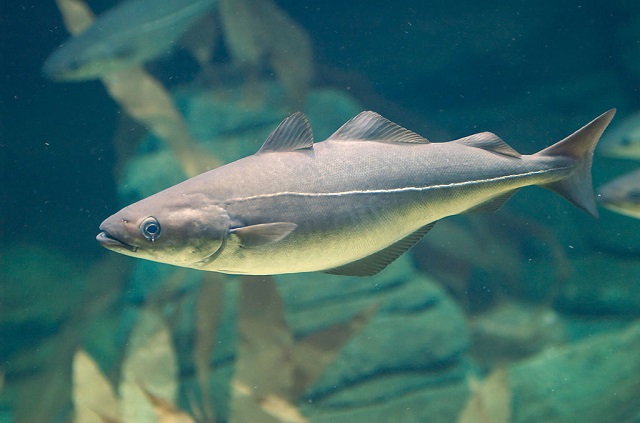
Photo: Tino Strauss, CC BY-SA 3.0, via Wikimedia Commons
| Latin Name | Pollachius virens |
| Diet | Predominantly feeds on crustaceans and smaller fish. |
| Best time to see | May to August. |
| Distribution | Saithe can be found throughout the UK’s waters, however they are most common around Scotland. |
| Habitat | Usually seen in inshore waters over spring and summer, before moving to depths of up to 350 m in winter. |
| How to find | Snorkelling/Diving. |
| Interesting fact | Saithe have a large number of common names, including the coalfish, coley, billet, black pollack, blackjack, glassen, Boston blue and – in North America – the pollack. |
Dragonets
Common Dragonet
Common dragonets have flattened, triangular heads and long snouts. Females are drab in colour, while males are orange with bright blue markings and elongated dorsal fins. They average 14 cm in length.
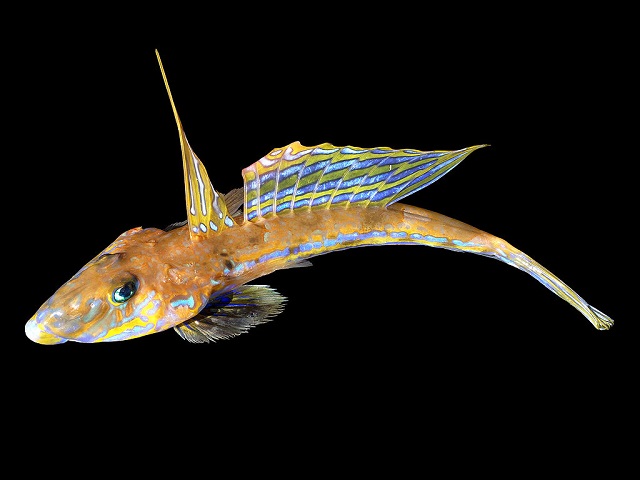
Photo: © Hans Hillewaert
| Latin Name | Callionymus lyra |
| Diet | Favours crustaceans and other invertebrates such as worms, although small fish will also be eaten. |
| Best time to see | June to September. |
| Distribution | Common dragonets are widespread along all UK coastlines. |
| Habitat | Usually lives on the seafloor, to depths of 50 m. Prefers areas of sandy or gravely sediment where it can lie partially buried. |
| How to find | Snorkelling/Diving. |
| Interesting fact | Male common dragonets are highly territorial and will defend their areas aggressively from other males. They engage females in elaborate courtship rituals. |
Reticulated Dragonet
With a flattened head and body, the reticulated dragonet averages 8 cm in length. It has distinctive markings, with brown saddle markings along its back and bluish-white spots.
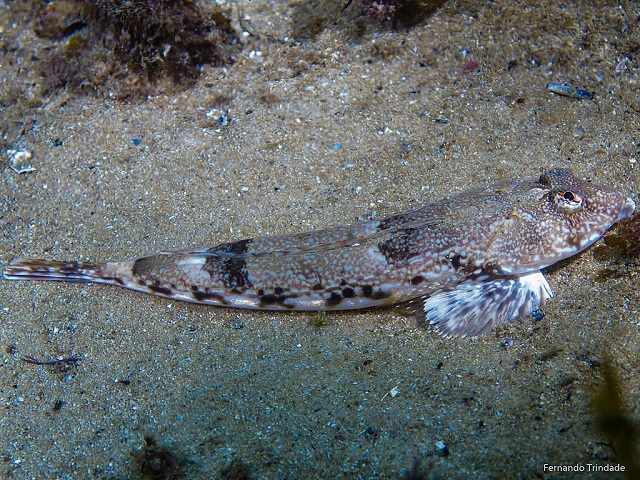
Fernando trindade, CC BY 3.0, via Wikimedia Commons
| Latin Name | Callionymus reticulatus |
| Diet | Feeds predominantly on small invertebrates such as worms, shrimp and crabs. |
| Best time to see | June to September. |
| Distribution | Reticulated dragonets can be found around much of the UK, although tend to be uncommon. |
| Habitat | Mainly occurs on sandy shores in shallow waters, to depths of around 100 m. It particularly favours estuaries. |
| How to find | Snorkelling/Diving. |
| Interesting fact | Reticulated dragonets spawn during the spring months, with the eggs drifting on ocean currents for a short period before hatching into tiny larvae. |
Eels
European Conger
The European conger is the largest eel species in the world, growing to lengths of 1.5 m on average. It is usually grey to black in colour and has a rounded snout, lacking scales.
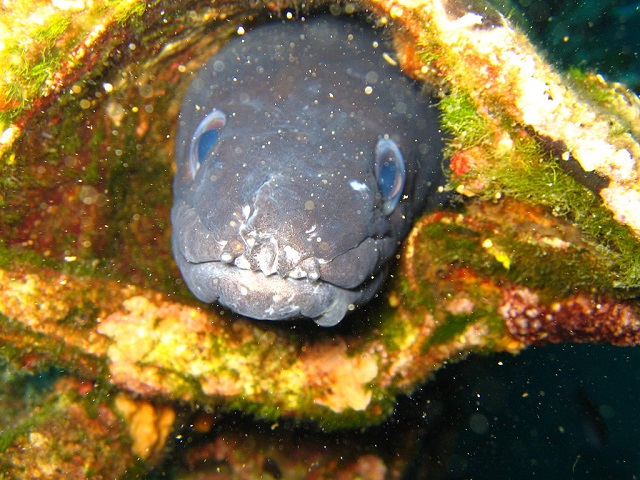
West Brom 4ever, Public domain, via Wikimedia Commons
| Latin Name | Conger conger |
| Diet | Preys on fish, squid and crabs, but will also feed on dead animals on occasion. |
| Best time to see | June to September. |
| Distribution | European congers are concentrated mainly around south-west England and Wales, with a few records from Scotland. |
| Habitat | Often seen in rocky areas, where it hides in crevices or in wrecks during the day. Young individuals may live in shallow water, while adults venture to depths of 4,000 m. |
| How to find | Snorkelling/Diving. |
| Interesting fact | European conger eels mature between 5 and 15 years of age, migrating to very deep waters to spawn. Females produce several million eggs and spawning occurs only once, with the adults dying afterwards. |
Molas
Ocean Sunfish
The ocean sunfish is a peculiar species, being flattened and circular in appearance, with no defined tail. It has two long fins and is very large, measuring 1.8 m in length on average.

Photo: Per-Ola Norman, Public domain, via Wikimedia Commons
| Latin Name | Mola mola |
| Diet | Feeds mainly on jellyfish, but will also prey on squid, small fish and crustaceans. |
| Best time to see | June to September. |
| Distribution | Ocean sunfishes are largely summer visitors to south-western coasts, although they can be spotted occasionally around all UK waters. |
| Habitat | Lives in open water and ranges to depths of around 360 m. |
| How to find | Diving/Boating/Viewing from the shore. |
| Interesting fact | The ocean sunfish is the second heaviest bony fish on the planet, beaten only by its close relative – the southern sunfish. The heaviest individuals can reach 2 tonnes. |
Sharks
Basking Shark
As the largest fish of UK waters, the basking shark measures 7.9 m in length on average. It has a large, triangular shaped dorsal fin and an enormous mouth. It is generally grey in colour.
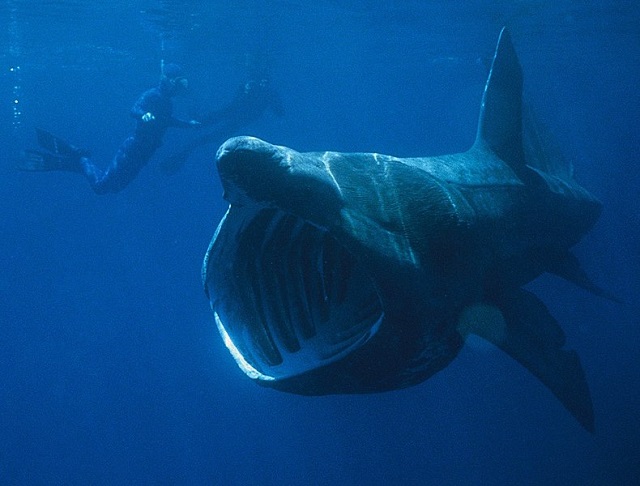
Photo by Chris Gotschalk
| Latin Name | Cetorhinus maximus |
| Diet | Feeds mainly on zooplankton. |
| Best time to see | June to August. |
| Distribution | Basking sharks are summer visitors to western coasts of the UK, seen most often around Cornwall and south-west Scotland. |
| Habitat | Lives in the open ocean to depths of 1,200 m, but is often found around continental shelf regions. |
| How to find | Diving/Boating/Viewing from the shore. |
| Interesting fact | Basking sharks undergo incredible long-distance migrations during the summer and winter, travelling thousands of kilometres to seek out the best zooplankton feeding grounds. |
Blue Shark
Named after its metallic blue colour, the blue shark has a torpedo-shaped body and long pectoral fins. It averages 2.6 m in length and has distinctively large eyes.

Diego Delso, CC BY-SA 4.0, via Wikimedia Commons
| Latin Name | Prionace glauca |
| Diet | Favours fish and squid, although will also prey on seabirds. |
| Best time to see | June to September. |
| Distribution | Blue sharks are largely restricted to the south-west coast of England, which they visit during summer. |
| Habitat | Can be found in the open ocean, from the surface to depths of 400 m. |
| How to find | Boating/Diving. |
| Interesting fact | Unusually for fish, blue sharks are viviparous – giving birth to live young. The fertilised eggs are nourished within the female’s uterus by a special yolk-sac for around nine months, where they develop into juvenile sharks. |
Nursehound
The nursehound is a relatively stocky species of catshark, measuring 1.2 m in length. It is pale in colour with large, dark spots all over its body.

Photo: Petra Karstedt (User admin at tiermotive.de), CC BY-SA 2.5, via Wikimedia Commons
| Latin Name | Scyliorhinus stellaris |
| Diet | Predominantly preys on bottom-dwelling fish and crustaceans. |
| Best time to see | June to September. |
| Distribution | Nursehounds are distributed right around the UK, although are more common on western shores. |
| Habitat | Prefers rocky ground or seaweed beds, and is often seen on the seafloor. Occurs to depths of 100 m. |
| How to find | Snorkelling/Diving. |
| Interesting fact | Nursehounds are nocturnal sharks, emerging at night to hunt for food. During the day, they often shelter in rock crevices, with several sharks sometimes living in the same hole. |
Porbeagle Shark
Porbeagle sharks are very robust and streamlined in shape, with large black eyes. They average 2.5 m in length and are bluish in colour, with white undersides and a white dorsal fin mark.
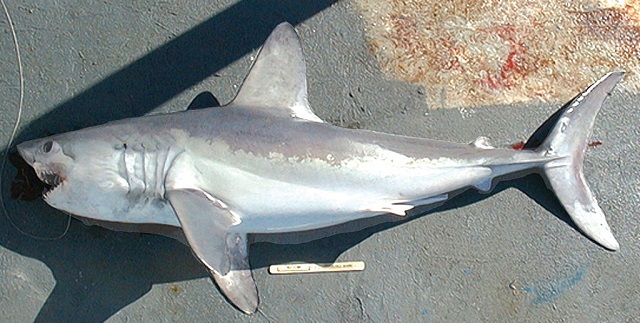
Photo: NOAA, Public domain, via Wikimedia Commons
| Latin Name | Lamna nasus |
| Diet | Primarily feeds on bony fish and squid. |
| Best time to see | June to August. |
| Distribution | Porbeagle sharks can generally be found throughout the UK. |
| Habitat | Prefers areas of open water down to depths of 700 m, but will also move into shallower, coastal regions during the summer months. |
| How to find | Diving |
| Interesting fact | The porbeagle shark is the closest living relative of the great white shark. Its similar appearance means it is sometimes mistaken for its cousin, however the porbeagle is much smaller. |
Spurdog Shark
Spurdog sharks have streamlined bodies and pointed snouts, with spines in front of their dorsal fins. They are greyish-brown in colour and have a series of white spots down their sides.

| Latin Name | Squalus acanthias |
| Diet | Preys on a range of marine organisms, including fish, crustaceans, squid and jellyfish. |
| Best time to see | June to August. |
| Distribution | Spurdog sharks live right around the UK coast, although are less common in the English Channel. |
| Habitat | Occurs in both inshore waters and deeper areas around the continental shelf. |
| How to find | Snorkelling/Diving. |
| Interesting fact | The spurdog shark’s spines secrete a mild venom, which the shark uses as a defence mechanism against larger predators. |
Small-Spotted Catshark
Small-spotted catsharks are pale in colour, with distinctive brown spots all over their bodies. They are small, slender sharks, which generally measure around 55 cm in length.

Photo: © Hans Hillewaert
| Latin Name | Scyliorhinus canicula |
| Diet | Preys on crustaceans and smaller fish, as well as the occasional mollusc. |
| Best time to see | June to September. |
| Distribution | Small-spotted catsharks occur throughout the UK’s waters. |
| Habitat | Favours shallow waters, especially over sandy or muddy substrate. Lives to depths of 100 m. |
| How to find | Snorkelling/Diving. |
| Interesting fact | Confusingly, the small-spotted catshark is also known as the lesser-spotted dogfish or rough hound. It is often called ‘rock salmon’ when served in fish and chip shops. |
Thresher Shark
Thresher sharks can be identified by their distinctive long tails, which can be as long as their bodies. They average 4.2 m in length and are greyish-brown in colour.
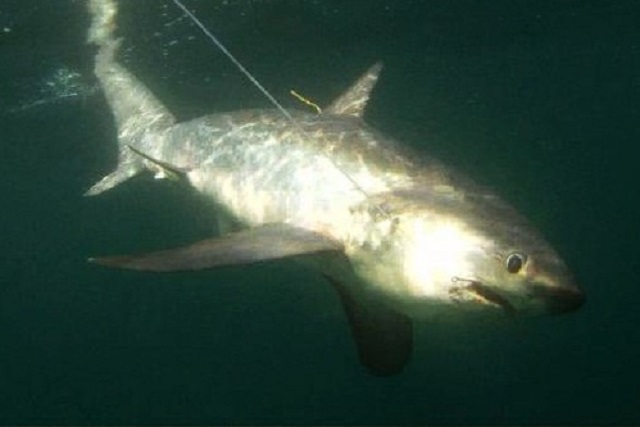 Photo: NOAA/PIER, Public domain, via Wikimedia Commons
Photo: NOAA/PIER, Public domain, via Wikimedia Commons
| Latin Name | Alopias vulpinus |
| Diet | Preys on schooling fish such as mackerel and herring. |
| Best time to see | June to August. |
| Distribution | Thresher sharks occur throughout much of the UK’s waters. |
| Habitat | Young individuals can be seen close to shore in shallow waters, while adults move to deeper areas over the continental shelf. |
| How to find | Diving |
| Interesting fact | Thresher sharks use their extremely long tails as weapons to incapacitate fish. When attacking a shoal, they lash their tails violently like whips, stunning any fish that are contacted. |
Rays
Common Skate
The common skate is generally brown in colour, with a series of light blotches on its back. It is a large ray, measuring 1.2 m in length on average, and has a pointed snout.
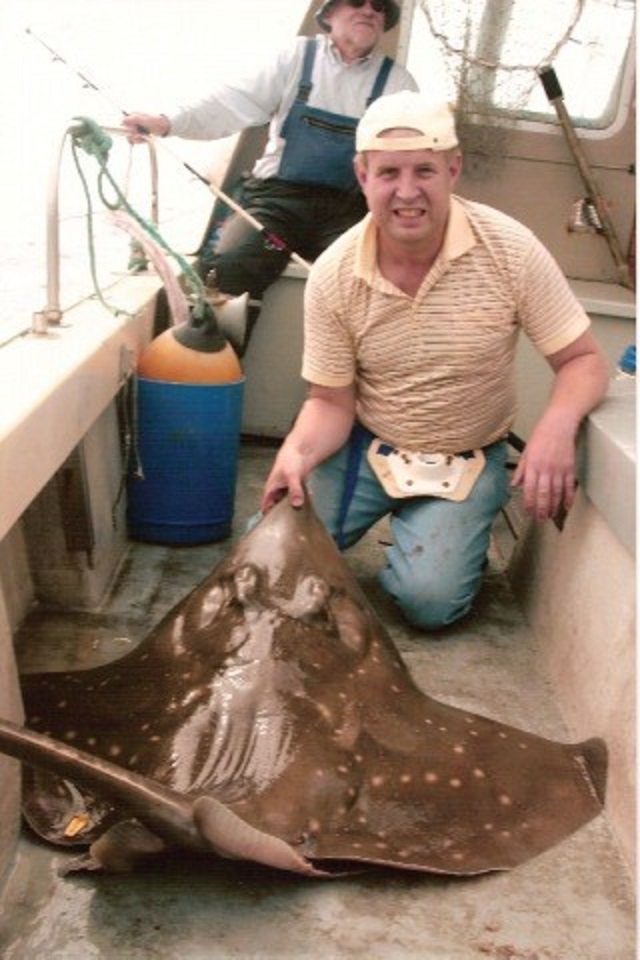
By Peter van der Sluijs – Own work, CC BY-SA 3.0, https://commons.wikimedia.org/w/index.php?curid=16419420
| Latin Name | Dipturus batis |
| Diet | Mainly feeds on crustaceans, although will also catch small fish. |
| Best time to see | June to September. |
| Distribution | Common skates can be found off the coasts of north-west Scotland and Northern Ireland. |
| Habitat | Favours sandy or muddy substrates, with young individuals living in shallow waters and adults ranging to as deep as 600 m. |
| How to find | Snorkelling/Diving. |
| Interesting fact | The name ‘common skate’ is rather misleading. Although the species was once abundant in the Atlantic Ocean, it is now critically endangered due to the negative impacts of fisheries. |
Cuckoo Ray
Cuckoo rays can be identified by the two large eyespots on their wings, which are yellow and black in colour. Their bodies are pale brown and measure 58 cm in length.
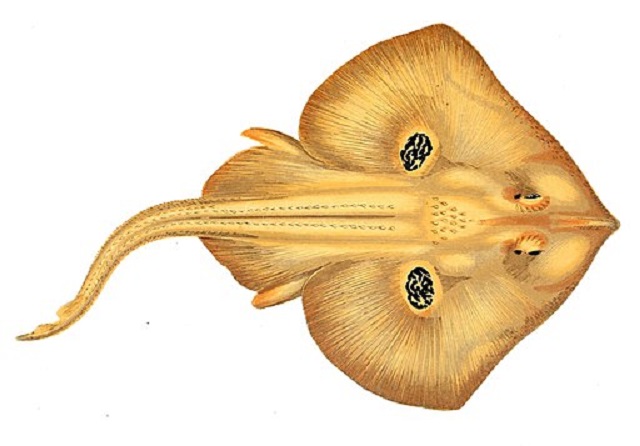
Gervais et Boulart, Public domain, via Wikimedia Commons
| Latin Name | Leucoraja naevus |
| Diet | Favours small crustaceans and worms, as well as the occasional fish. |
| Best time to see | June to September. |
| Distribution | Cuckoo rays can be found right around the UK, although they are most common in the warmer waters around southern coasts. |
| Habitat | Mainly seen between depths of 0 and 250 m, over sandy or muddy substrates. |
| How to find | Snorkelling/Diving. |
| Interesting fact | Cuckoo rays lay between 70 and 150 eggs per year, which take the form of egg cases that are often referred to as ‘mermaid’s purses’. Empty cases regularly wash up on the shore. |
Spotted Ray
The spotted ray is a small, diamond-shaped ray which averages 60 cm in length. Hence its name, it is covered in dark spots, which are set against a pale base colour.
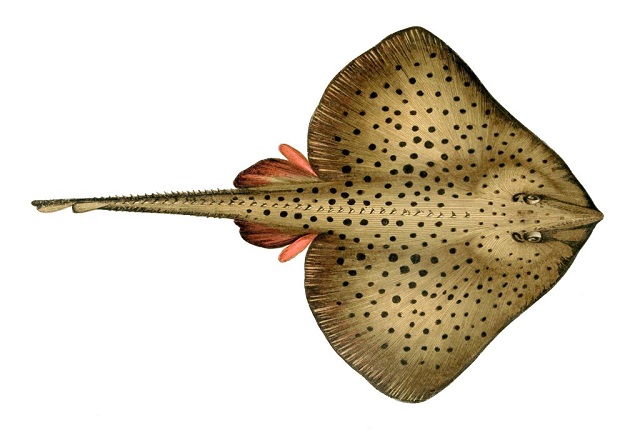
Photo: Gervais et Boulart, Public domain, via Wikimedia Commons
| Latin Name | Raja montagui |
| Diet | Preys on a variety of marine life, including crustaceans, worms and fish. |
| Best time to see | June to September. |
| Distribution | Spotted rays are distributed throughout the UK’s waters, but are most common in the English Channel. |
| Habitat | Generally lives on sandy substrates, at depths between 100 and 300 m. Juveniles often inhabit shallower areas. |
| How to find | Snorkelling/Diving. |
| Interesting fact | The spotted ray possesses two unique holes on its back, just behind the eyes. These are known as spiracles and help the ray to breathe while it is buried within the sand. |
Thornback Ray
The thornback ray is kite-shaped and can be identified by having a series of spines down its back and tail. It measures 67 cm in length on average and is generally grey with dark blotches.

© Hans Hillewaert
| Latin Name | Raja clavata |
| Diet | Primarily feeds on crustaceans, but will also eat small fish. |
| Best time to see | April to June. |
| Distribution | Thornback rays can be found on all UK coastlines. |
| Habitat | Lives in a range of habitats, but prefers shingle or gravel substrates. Although ranging to depths of 300 m, it is often seen close to shore. |
| How to find | Lives in a range of habitats, but prefers shingle or gravel substrates. Although ranging to depths of 300 m, it is often seen close to shore. |
| Interesting fact | Thornback rays move closer to shore during the spring, where they congregate and breed. The eggs are deposited on the seafloor and are anchored down with adhesive film. |
References:
Animal Diversity Web – https://animaldiversity.org/
FishBase – https://www.fishbase.se/home.htm
The Marine Life Information Network – https://www.marlin.ac.uk/
National Biodiveristy Network – https://nbn.org.uk/
Ocean Eye Photo – https://www.oceaneyephoto.com/
RSPB – https://www.rspb.org.uk/
Scottish Wildlife Trust – https://scottishwildlifetrust.org.uk/
The Wildlife Trusts – https://www.wildlifetrusts.org/
